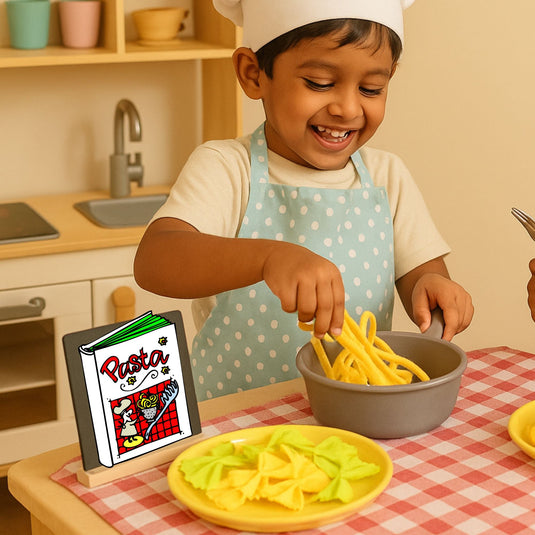Creating a pretend play pasta shop in a dramatic play area for kids is a fantastic and imaginative activity. Here's a guide on how to set up this engaging play space:
1. Define the Space:
- Choose a designated area for the pasta shop. It could be a corner of a room or a specific table. Ensure there is enough space for various play elements.
2. Gather Supplies:
- Collect play food items such as different types of pasta (spaghetti, penne, fusilli), pretend sauces, vegetables, and condiments. You can use felt, fabric, or plastic materials to create these items.
3. Set Up a Play Kitchen or Counter:
- Arrange a play kitchen or create a simple counter space where children can "cook" and assemble their pasta dishes. Include pots, pans, and utensils for stirring and serving.
4. Display Pasta Types:
- Showcase various types of play pasta in containers or baskets. Label each container with the type of pasta to introduce children to different shapes and varieties.
5. Include Toppings and Sauces:
- Provide pretend toppings like grated cheese, tomato sauce, pesto, and vegetables. Use small containers or jars for these items and encourage children to mix and match ingredients.
6. Set Up a Cashier Area:
- Create a cashier area with a register, play money, and a small menu board. This adds a math component to the play as children take on the roles of both customers and cashiers.
7. Aprons and Chef Hats:
- Enhance the role-playing experience by providing aprons and chef hats for the little pasta chefs. This adds a sensory element and helps immerse them in the pretend play.
8. Create Menus:
- Develop simple menus with pictures or illustrations of different pasta dishes. Display the menus in the play area to guide children in their role-playing scenarios.
9. Encourage Storytelling:
- Promote storytelling during play by asking children to create stories around their pasta shop. Encourage them to discuss their favorite pasta dishes, share recipes, and interact with customers.
10. Customer Interaction:
- Encourage children to take turns being both the customer and the pasta chef. This promotes social interaction, communication, and role reversal.
11. Rotate Ingredients:
- To keep the play dynamic and interesting, consider rotating the play food items and introducing new elements periodically. This allows children to explore different pasta recipes and combinations.
12. Reflect and Discuss:
- After the play session, gather the children to discuss their experience. Ask questions like:
- What was your favorite part of running the pasta shop?
- Did you enjoy being a customer or a pasta chef more?
- What pasta dish did you like creating the most?
Setting up a pretend play pasta shop not only stimulates creativity but also promotes fine motor skills, social interaction, and language development. It's a delightful way for children to engage in imaginative play and learn about different aspects of the world around them.
Shop The Small Wonderland's Pretend Play pasta set for making this experience more enjoyable.




